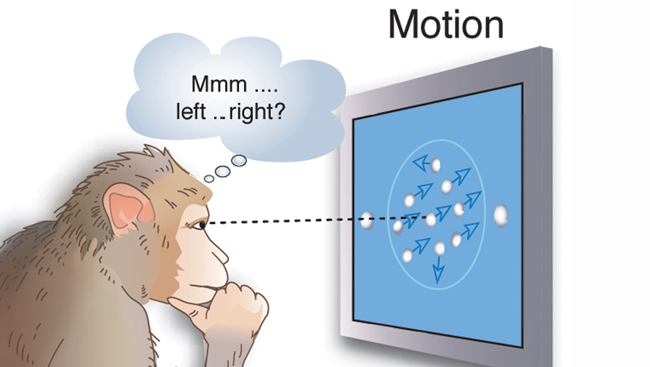Decision-Making
- Published1 Oct 2009
- Reviewed9 Apr 2013
- Author Susan Perry
- Source BrainFacts/SfN
Decision-making is such a seamless brain process that we’re usually unaware of it — until our choice results in unexpected consequences. Then we may look back and wonder, “Why did I choose that option?” In recent years, neuroscientists have begun to decode the decision-making process. What they’re learning is shedding light not only on how the healthy brain performs complex mental functions, but also on how disorders, such as stroke or drug abuse, affect the process.
Researchers can study decision-making in animals. As monkeys decide which direction a moving target is headed, researchers record the activity in brain cells called neurons. These studies have helped to reveal the basis for how animals and humans make everyday decisions.
Decisions. Decisions. Each day you make thousands of them. Many — what to eat for breakfast or what to wear to a friend’s party — have few, if any, long-lasting consequences. Others — whether to stay in school or look for work — can have a huge impact on the direction of your life.
Neuroscientists have long questioned how the human brain makes decisions, from where to gaze to complex moral judgments. Research suggests that the brain considers various sources of information before making a decision. But how does it do this? And why does the process sometimes go awry, causing us to make impulsive, indecisive, and confused decisions — the kinds that can lead to risky and potentially dangerous behaviors?
Thanks to advances in technology, researchers are beginning to unravel the mysterious processes by which humans make decisions. New research is helping scientists develop:
- A deeper understanding of how the human brain reasons, plans, and solves problems.
- Greater insight into how sleep deprivation, drug abuse, neurological disorders, and other factors affect the decision-making process, suggesting new behavioral and therapeutic approaches to improve health.
Our brains appear wired in ways that enable us, often unconsciously, to make the best decisions possible with the information we’re given. In simplest terms, the process is organized like a court trial. Sights, sounds, and other sensory evidence are entered and registered in sensory circuits in the brain. Other brain cells act as the brain’s “jury,” compiling and weighing each piece of evidence. When the accumulated evidence reaches a critical threshold, a judgment — a decision — is made.
Where these judgments are made in the brain differs depending on the type of decision. For example, by studying stroke patients, researchers found that different parts of the frontal lobe, an area involved in planning and reasoning, are important in abstract and concrete decisions. People with stroke damage in the front of this brain region had trouble with abstract decisions, such as deciding to wash dishes, whereas people with damage in the back had trouble with concrete decisions, like the selection of physical movements during dishwashing. Other researchers studying monkeys found that decisions based on visual information rely on the parietal lobe, which integrates evidence supplied by the senses.
In these different brain regions, research shows that decisions result from rapid and complex probability calculations in brain cells called neurons. In one study, monkeys played a video game that required them to determine which of two possible directions a moving display of random dots was headed. If a monkey guessed the direction correctly — by gazing at one of the two targets — it received a reward. As the monkey made its decisions, researchers recorded the electrical activity of neurons in the parietal lobe, and found that it closely correlated with the monkey’s decisions. In fact, the researchers could predict the monkey’s choices based solely on brain cell activity.
Neuronal activity in the parietal lobe not only accurately predicted the monkey’s choice, but also the certainty with which the decision was made. In addition to trying to select the correct target for a big reward, the monkeys were able to choose a fixed target, which guaranteed a smaller, less desirable reward. When the monkey lacked confidence in its target selection, it chose the sure bet, and the brain cell activity in its parietal lobe changed, suggesting these cells also indicate the monkey’s confidence level.
What happens when we change our minds? Scientists have found that when a decision goes wrong and things turn out differently than expected, the orbitofrontal cortex, located at the front of the brain behind the eyes, responds to the mistake and helps us alter our behavior. Interestingly, researchers have found that cocaine addicts, who are often unable to weigh the rewards of drug use against its costs, show impairments of the orbitofrontal cortex.
In addition to drug abuse, other factors can cause the decision-making mechanisms in the brain to go awry, leading to risky or even dangerous behaviors. One study found, for example, that losing a full night’s sleep caused people to adopt much riskier-than-normal gambling strategies.
All these findings indicate how much researchers have learned and how much is yet to be learned about how and why we make decisions, one of our most complex and essential human behaviors.
CONTENT PROVIDED BY
BrainFacts/SfN



















